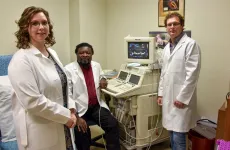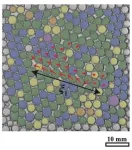(Press-News.org) Online searches for mobile and isolated activities can help to predict later surges and declines in COVID-19 cases, a team of researchers has found. Its findings, based on a four-month analysis of online searches, offer a potential means to anticipate the pathways of the pandemic--before new infections are reported.
"This is a first step towards building a tool that can help predict COVID case surges by capturing higher-risk activities and intended mobility, which searches for gyms and in-person dining can illuminate," says Anasse Bari, a clinical assistant professor in computer science at New York University's Courant Institute of Mathematical Sciences and one of the authors of the paper, which appears in the journal Social Network Analysis and Mining. "Using such 'alternative data' is nothing new and has been applied for other purposes--for instance, alternative data has been used in finance to generate data-driven investments, such as studying satellite images of cars in parking lots to predict businesses earnings."
"Our research shows the same techniques could be applied to combatting a pandemic by spotting, ahead of time, where outbreaks are likely to occur," adds Megan Coffee, a clinical assistant professor in the Division of Infectious Disease & Immunology at NYU Grossman School of Medicine. "Developing a barometer of behavior would, with further work and validation, allow policymakers and epidemiologists to track the impact of social interventions and brace for rising surges."
The research also showed an association between intended activities outside the home after lockdown restrictions were lifted, pointing to how the effects of policy decisions can be measured using alternative data.
Since the onset of the pandemic, governments have restricted activities, often based on surges of COVID-19 cases, then loosened these restrictions after declines. However, these actions are in response to infection rates and are designed to limit the spread of future cases.
In the Social Network Analysis and Mining study, the researchers sought to determine if there were ways to spot behaviors known to be risky during the pandemic (e.g., visits to barbershops and nail salons) ahead of local and regional outbreaks--and conversely, identify behaviors known to be less risky (e.g., exercising at home) prior to declines in coronavirus cases.
"Our goal was to capture the underlying social dynamics of an unprecedented pandemic using alternative data sources that are new to infectious disease epidemiology," explains Bari. "When someone searches the closing time of a local bar or looks up directions to a local gym, they give some insight into what future risks they may have."
To examine this, they studied online searches from March through June in 2020 in all 50 states. Here, they divided searches into two categories--or "tracks": a mobility index track, which categorized searches linked to interactions with others outside the home (e.g., "theaters near me," "flight tickets"), and an isolation index track, which categorized searches linked to activities done at home ("food delivery," "at-home yoga").
The team's choice of search keywords was informed by a recent Democracy Fund + UCLA Nationscape survey that tracked activities individuals reported they would prioritize attending if "restrictions were lifted on the advice of public health officials regarding activities." The most popular results included "going to a stadium/concert," "going to the movies," and "attending a sports event."
Using Google Trends data, the researchers tracked search trends related to mobility and isolation to develop mobility and isolation indexes. They complemented these with a "net movement index," which was the difference between the mobility index and the isolation index.
The researchers then looked at COVID-19 case growth 10 to 14 days later--the expected lag between exposure and symptoms--at the state level by examining data from state and local health agencies.
Overall, they found that the net movement index correlated with new COVID-19 cases--reported weekly--in 42 of 50 states over the studied period (March-June 2020).
The researchers also looked more closely at five states (Arizona, California, Florida, New York, and Texas) to determine the impact of the ending of stay-at-home orders on searches. In all of these states, the mobility index, which decreased during the initial lockdown phase, increased as re-openings began. Subsequently, COVID-19 cases rose again nationwide in June 2020 and surged in Arizona, California, Florida, and Texas.
By contrast, an earlier sharp decline in mobility indices was followed by a sharp decline in the case growth data in these same five states.
"From this work, we hope to build a knowledge base on human behavior change from alternative data during the life cycle of the pandemic in order to allow machine learning to predict behavior in future epidemics," says Aashish Khubchandani, an NYU undergraduate and one of the paper's authors.
The researchers recognize that search-based methods to predict infection outbreaks raise privacy concerns. However, they emphasize that their tool uses large volumes of search queries, not individual ones, and relies on anonymized data in order to offer health-related projections.
INFORMATION:
The paper's other authors were Courant researchers Matthias Heymann and Junzhang Wang, who are part of the Predictive Analytics and AI research lab at the Courant Institute.
The study was supported, in part, by an Amazon AI research grant and an NYU COVID-19 Catalyst Research grant.
DOI: 10.1007/s13278-021-00723-5
AUGUSTA, Ga (Feb. 8, 2021) - Starting with early childhood, otherwise healthy Black people show signs of slightly diminished heart muscle strength and a slightly higher blood pressure than their white counterparts, factors which may put them on a course for early development of congestive heart failure, researchers report.
The take-home message for parents and physicians is that, particularly for populations at high cardiovascular risk such as Black people, a close check should be kept on blood pressure starting in early adolescence, says the corresponding author of the study in Journal of the American Heart Association.
Children ...
Efforts to improve the social success of autistic adolescents and adults have often focused on teaching them ways to think and behave more like their non-autistic peers and to hide the characteristics that define them as autistic. Psychology researchers at The University of Texas at Dallas, however, have been focusing on another approach: promoting understanding and acceptance of autism among non-autistic people.
The researchers published their findings online Jan. 20 in the journal Autism. The study showed that familiarizing non-autistic people with the challenges and strengths of autistic people helped to reduce stigma and misconceptions about autism, but implicit biases about autism were harder to overcome.
Desiree Jones, a psychology doctoral student ...
Beer-Sheva, Israel...February 8, 2021 - A new discovery by researchers from Ben-Gurion University of the Negev (BGU) and its affiliated Soroka University Medical Center shows that medical cannabis may reduce blood pressure in older adults.
The study, published in the European Journal of Internal Medicine, is the first of its kind to focus on the effect of cannabis on blood pressure, heart rate and metabolic parameters in adults 60 and above with hypertension.
"Older adults are the fastest growing group of medical cannabis users, yet evidence on cardiovascular safety for this population is scarce," says Dr. Ran Abuhasira of the BGU Faculty of Health Sciences, one of Israel's leading medical ...
It's well understood that a difficult childhood can increase the likelihood of mental illness, but according to new research from the University of South Australia, a happy and secure childhood does not always protect a child from developing a mental illness later in life.
Conducted in partnership with the University of Canberra, the finding is part of a study published in Current Psychology, which examined how early childhood experiences relate to different developmental pathways, and how these might be associated with poor mental health.
Given that both positive and negative childhood experiences were found to manifest as anxiety or other mental health disorders into adulthood, ...
Tokyo, Japan - Researchers from Tokyo Metropolitan University studied the dynamics of foams. When a drop of water was added to a foam raft, the bubbles rearranged themselves to reach a new stable state. The team found that bubble movement was qualitatively different depending on the range of bubble sizes present. Along with analogies with soft-jammed materials, these findings may inspire the design of new foam materials for industry.
Foams are everywhere. Whether it's soaps and detergents, meringues, beer foam, cosmetics or insulation for clothing and building, we're surrounded by everyday ...
There is an urgent need for guidelines on how schools can use ventilation to reduce the risk of COVID-19 transmission in the classroom, according to doctors at Imperial College London and the headteacher of a secondary school in Pinner, Middlesex. In a commentary published by the Journal of the Royal Society of Medicine, the authors say that improving air quality in classroom spaces should be as important as following government advice regarding social distancing, mask-wearing and hand washing.
The authors point to lessons from the airline industry, where the risk of contracting COVID-19 on a flight ...
6 February: The IMbrave150 trial found median overall survival was 19.2 months in patients treated with atezo+bev vs 13.4 months for those treated with sorafenib alone, the current standard treatment (HR, 0.66 [95% CI, 0.52-0.85]; P=0.0009). Survival at 18 months was 52% with atezo+bev and 40% in patients treated with sorafenib.
All patients in the trial had nonresectable HCC - the most common form of liver cancer - and had not previously been treated with systemic therapy. A total of 501 patients were treated in the multicentre, open label, randomised controlled trial and the new follow-up figures confirm the superiority of the atezo+bev combination over sorafenib in this group of patients with HCC.
Atezolizumab is an immune ...
Around one in three working-age adults (29%) surveyed in France in July 2020 would refuse any COVID-19 vaccine.
Willingness to receive a COVID-19 vaccination depended upon its country of origin, effectiveness, rate of serious side effects, and site of vaccination.
Although attitudes may have changed since July 2020 with the approval of several vaccines and a second wave of COVID-19, the findings suggest that communicating the collective benefits of herd immunity reduced people's hesitancy about being vaccinated.
Nearly one in three working-age adults in France (29%) surveyed in July 2020 - when lockdown restrictions had been ...
TORONTO (February 5, 2021) - A clinical study led by Dr. Jordan Feld, a liver specialist at Toronto Centre for Liver Disease, University Health Network (UHN), showed an experimental antiviral drug can significantly speed up recovery for COVID-19 outpatients - patients who do not need to be hospitalized.
This could become an important intervention to treat infected patients and help curb community spread, while COVID-19 vaccines are rolled out this year.
"This treatment has large therapeutic potential, especially at this moment as we see aggressive variants of the virus spreading around the globe which are less sensitive to both vaccines and treatment ...
NEW YORK, NY (Feb. 5, 2020)--Cells used to study the human blood brain barrier in the lab aren't what they seem, throwing nearly a decade's worth of research into question, a new study from scientists at Columbia University Vagelos College of Physicians and Surgeons and Weill Cornell Medicine suggests.
The team also discovered a possible way to correct the error, raising hopes of creating a more accurate model of the human blood-brain barrier for studying certain neurological diseases and developing drugs that can cross it.
The study was published online Feb. ...



